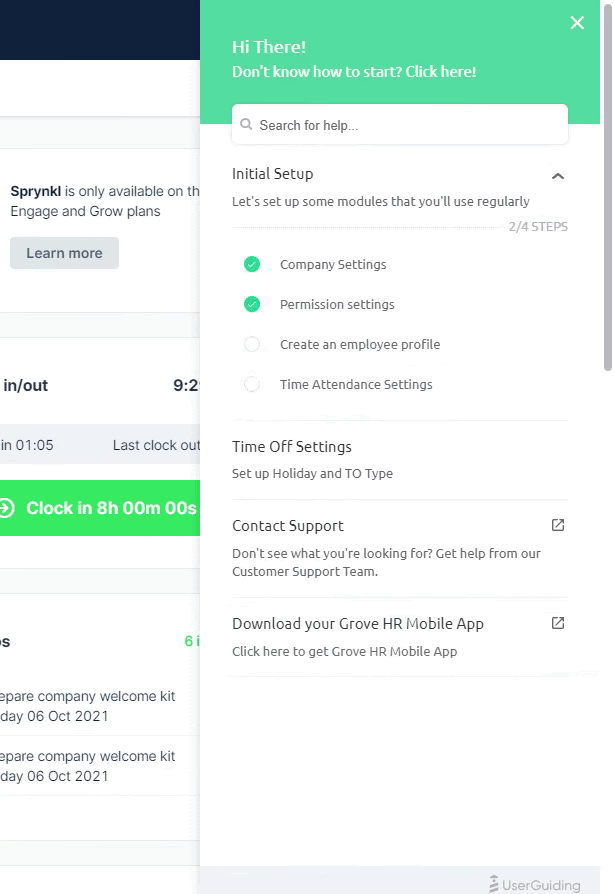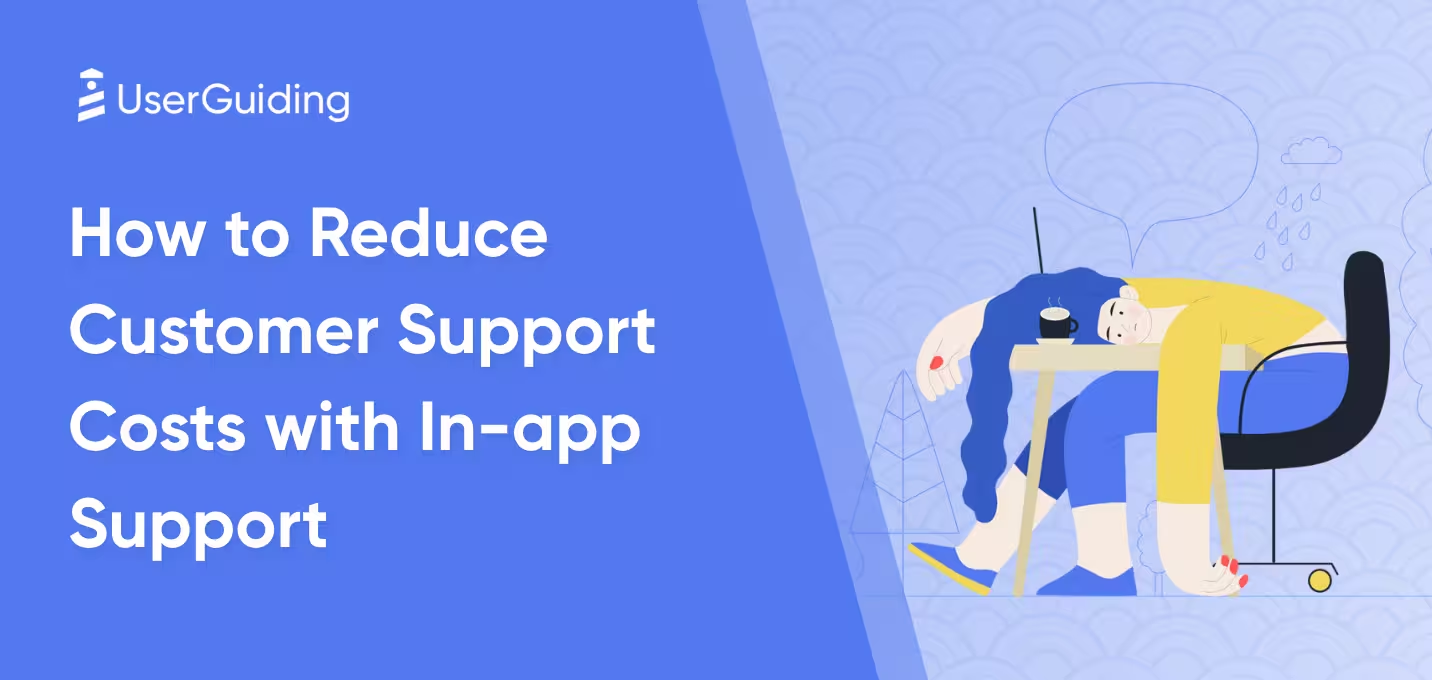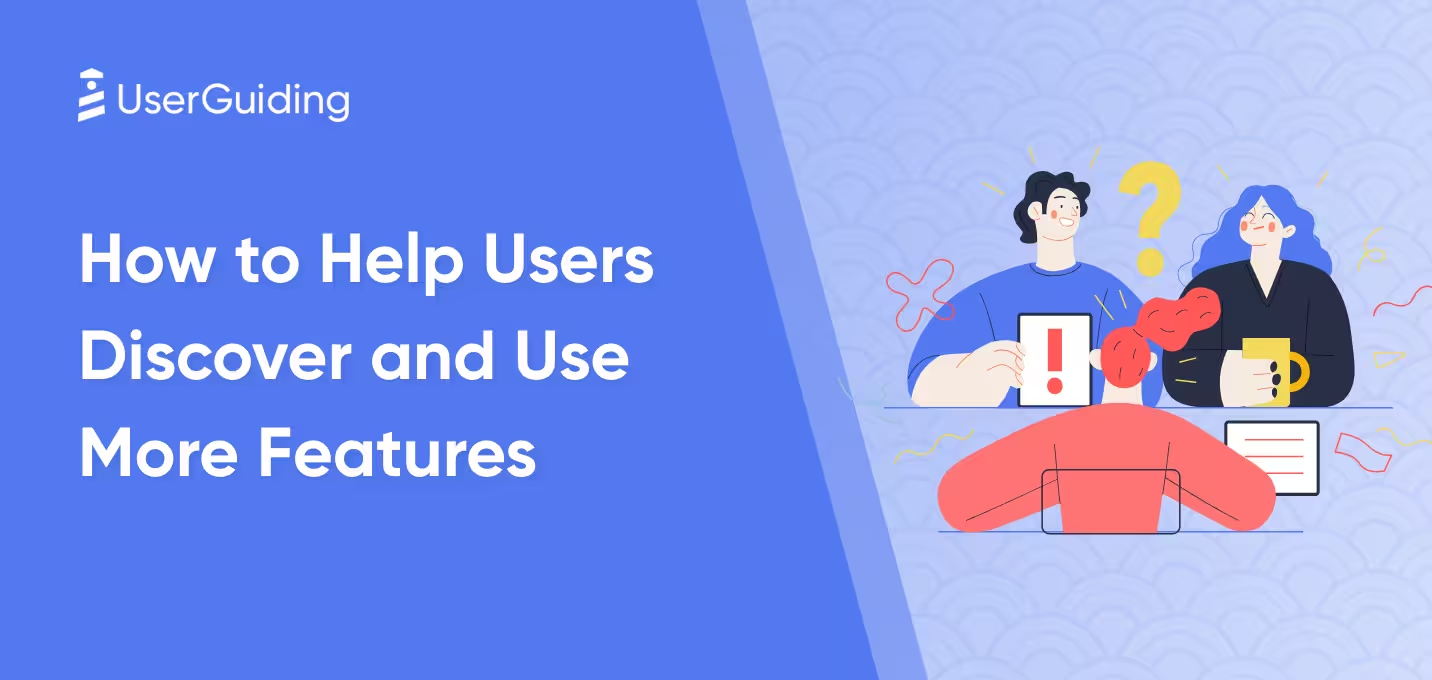

Understanding what your users truly want is key to building a successful SaaS product. User needs analysis helps you do just that.
User-centric approach, design thinking, Jobs To Be Done (JTBD) framework, lean UX…
There are a lot of concepts around product design & development.
Although their methodologies differ, they all share the same purpose: providing value to a target audience.
Thus, they all start with the user and go from there.

And that means whichever strategy or framework you use for your product, you need to have a clear definition of your target audience and know their problems, goals, and aspirations.
In this article, we’ll cover:
- Basics of user needs
- User research methods to detect these needs
- Steps you need to follow to analyze user needs
- Best practices in user needs analysis
Let’s get started!
TL;DR
- User needs analysis helps you understand what your users want and why they want it.
- User needs analysis allows you to both target the right audience and provide continuous value to your user base. User needs analysis is also important for:
- Detecting emerging trends and user needs,
- Maximizing the revenue potential of your product, and
- Increasing user satisfaction and loyalty.
- There are 3 types of user needs:
- Functional user needs
- Social user needs
- Emotional user needs
- User research methods can be categorized in mainly 2 groups:
- Attitudinal methods: methods in which you listen to users
- User interviews and surveys
- Focus groups
- Usability testing
- Behavioral methods: methods in which you observe the users
- Attitudinal methods: methods in which you listen to users
- 7 steps of user needs analysis are as follows:
- Define your user research objectives and goals within the SMART Framework.
- Choose the user segments for which you’ll conduct the research and the analysis.
- Examine product usage data and detect user behavior patterns.
- Use in-app surveys to gather qualitative user feedback.
- Categorize and group your findings.
- Conduct a prioritization analysis.
- Update your UX, product messaging, and roadmap according to your users’ needs.
- You can use UserGuiding to segment your users, create in-app surveys, and analyze your survey results.
- 👉🏻 Try it for free! 👈🏻
What is a user needs analysis?
User needs analysis is the process of collecting user data and examining it to understand your (potential) users’ goals, problems, and expectations from a possible solution.
Through user needs analysis, you get to know who your users are, what drives their behavior (emotions, pain points, goals, etc.), and what affects their decision-making process while buying a product/service.
User needs analysis helps you out in 2 ways:
- It helps you to target the right audience
- And also to optimize your product features and messaging to meet their requirements for your product and keep providing value to them.
So, it’s like creating a hook to catch and keep users.

Do you need to analyze user needs?
User needs analysis allows you to understand your target audience’s and existing user base’s current expectations of you.
–A.k.a. What you need for your future feature releases and product updates.
So, yes, you need to if you want to:
Design your roadmap to maximize revenue potential
If you want to ensure your SaaS product remains relevant and profitable, it's crucial to stay attuned to your users' evolving needs and preferences.
By proactively monitoring user behavior, feedback, and industry trends, you can identify emerging pain points and capitalize on new opportunities. This approach empowers you to make informed decisions about product development, feature enhancements, and pricing strategies, ultimately driving customer satisfaction and revenue growth.
Deliver continuous value to your users
Your users' needs are constantly changing. To keep them satisfied and loyal, you must continually adapt your product to meet their evolving expectations.
By understanding and addressing their pain points, you can maintain your product's value and ensure its long-term success.
Boost user satisfaction
This is a direct result of other two advantages of user needs analysis:
- Having a user-oriented product roadmap and
- Providing value to your users regularly.
Also, even asking your users about their use cases, pain points, and goals themselves adds to their satisfaction. When you do this, they feel valued and heard —not just like a number.
💡 Microsoft’s study shows us that 89% of users want to provide their input to companies through user feedback, but only 7% of companies almost always ask for it.
Plus, people think they can provide better insights about their use cases themselves:
💡 According to SurveyMonkey’s research, 91% of people believe that companies should drive innovation by paying attention to their buyers and customers, while only 31% percent think that hiring a team of experts is the best approach.
As you can see, it’s a two-for-one deal:
- You make users happy by hearing them out.
- And you plan much better feature updates with much less money.
Types of User Needs
A user need is basically motivates someone to sign up for your trial or subscribe to a plan. This need can be very obvious and articulated or hide behind certain goals and desires.
In order to detect these needs and play on them, you need to know how they present themselves.
📌 According to Harvard Business School, there are 3 types of user needs:
- Functional Needs
- Social Needs
- Emotional Needs
Let’s go over them one by one 👇🏻
Functional Needs
Functional needs are the most obvious and tangible needs out of the 3 types of user needs. They’re directly related to the job a user wants to be done from the user’s perspective. And from your perspective, it’s the main function of your product.
Functional needs can be general needs, like managing the sales pipeline.
Or, they can be more specific in terms of:
- Usability,
- Performance,
- Compatibility,
- Learnability,
- Accessibility, and
- Reliability.
Like managing the sales pipeline collaboratively on any device without spending hours learning how to navigate around the platform.
For example;
If a user has never used a navigation app before or hasn't encountered specific issues while using one, they likely have minimal expectations.
In this case, their functional need is simply a navigation app that helps them find their way.
However, if the same user has faced challenges navigating in areas with unreliable reception and felt disappointed by an app that only works with data…
Their functional need shifts to a navigation app that also provides offline map access.
If you know the specificities of your (potential) users’ needs, you can prioritize your feature updates and UX improvements accordingly and ensure high feature adoption for your releases.
Social Needs
Social needs are about how users perceive themselves (and are perceived by others) when using your product. They often revolve around status, community, and validation. Although social needs are hardly ever the main purchase decision drivers, they might affect the final decision.
Some examples of social needs can be:
- Being tech-savvy and in-tune with the times
- Adopting recent trends and practices in the industry
- Belonging to a community of users who have similar expertise
Emotional Needs
Emotional needs are similar to social needs in that they often take a secondary position to functional needs. While social needs spring from outside perception and impression, emotional needs spring from feelings.
If we go back to our sales pipeline management need and look for possible emotional needs of that user, we might see a need for:
- Confidence in decision-making
- Sense of achievement
- Recognition and validation
Other common emotional needs of SaaS users include:
- Security
- Privacy
- Comfort
- Visual appeal
- Reduced risk/ safety
- A sense of order and predictability
Research Methods for Discovering User Needs
There are several user research methods you can use to detect your users’ pain points, goals, and expectations of your product/service.
Yet, they all boil down to 2 main approaches:
- Speaking with your users and asking them directly (Attitudinal)
- Observing your users and deducing their needs and goals from their actions (Behavioral)

User interviews and surveys
User interviews and surveys are the most straightforward user research methods and fall under the attitudinal approach. Although both try to understand users by asking questions to users and listening to them, their strategies differ.
User interviews are 1:1 meetings in which you ask detailed and extensive questions to your users about their use cases, challenges they face, and expectations from you. They can help you uncover unique insights about your users; however, they’re not very easy to conduct due to time and resource constraints.
User surveys, on the other hand, allow you to reach out to a larger audience.
User surveys can include open-ended questions to get more detailed information, as well; yet, they often consist of easier and less time consuming questions. User surveys, particularly in-app surveys, let you gather insights quickly without needing to compile lengthy studies.
For instance, if you want to understand how a new or trial user is engaging with your product, there’s no need to send an email or schedule a 1:1 meeting. You can simply ask them directly through an in-app survey.
Efficient and hassle-free.

Focus groups
Focus groups allow you to combine attitudinal and behavioral approaches in a single study. In a focus group, you gather a small group of potential users and give them the opportunity to explore your product. You also encourage them to engage in a group discussion.
These sessions encourage open dialogue and participants to share feedback, ideas, and opinions. This is where you look for verbalized needs and expectations about your product.
Yet, also, as you see users engage with your product, try out features, and navigate around the UI, you can get some behavioral insights.
Usability testing
This is when you get involved with the trial process of your focus group users and ask them questions once they’ve tried out your product.
In a focus group, you take a step back and let users explore the product on their own and then have a peer discussion. This allows you to hear what goes through people’s minds after they used your product and how they felt during their experience.
Yet, with a usability test, you interact with users after they use your product.
So, the difference between a focus group and a usability test is that you do not get to ask questions to a focus group but you do ask questions during a usability test.
This method allows you to acquire deeper insights into their thought process and behavior.
For example, you can ask targeted questions to better understand your users' specific functional needs or how they feel after using a particular feature. You can even explore whether they’d prefer a different emotional experience, helping you refine both the functionality and the overall user satisfaction.
Here are some example questions you can ask during a usability test:
- What specific problem or goal does this feature help you solve?
(Purpose: To clarify the user’s primary need or motivation for using the product.) - Did the product meet your expectations for completing this task?
(Purpose: To gauge whether the functionality aligns with the user’s goals.) - Were there any points where you felt frustrated or confused?
(Purpose: To identify pain points that hinder the user experience.) - Is there anything you wish this feature could do that it currently doesn’t?
(Purpose: To uncover unmet needs or potential feature enhancements.) - Would you prefer a different way to achieve the same result?(Purpose: To discover alternative workflows that could better meet user needs.)
- How did using this feature make you feel? Was the experience as you expected?
(Purpose: To understand the emotional response tied to the product experience.)
Check the best usability testing tools here 👈🏻
A/B testing
Starting from here, you do not ask questions to your users anymore but you gather behavioral data and understand user needs and pain points by analyzing this data.
A/B testing is a user research method that compares two versions of a product aspect to see which performs better. It can be used to test and optimize any aspect of a product, including user interfaces, call-to-action buttons, pricing strategies, and onboarding processes.
By systematically testing different variables —such as color schemes, layouts, wording, or functionality— you can gather data on user behavior and preferences.
- Do your users need a more intuitive design?
- Do they respond better to visual cues or text prompts during critical tasks?
- Do they require additional educational in-app materials to navigate the learning curve?
- Would they feel more confident completing key actions with an interactive guide?
With A/B testing, you can uncover the answers to these questions and detect user needs that remain unvocalized by your users.
Check the best A/B testing tools here 👈🏻
Behavioral analytics
User behavior analytics is another way that provides insights into how users interact with your product. It’s important to know that, as it shows you what features are most valuable and where users encounter challenges and cannot solve their problems completely.
📌 3 of the most prominent tools of behavioral analytics are:
- Session recordings
- Heatmaps
- Sentiment analysis
Session recordings allow you to watch real-time or replayed user interactions within your product. By tracking behavior patterns such as navigation flow, clicks, and pauses, session recordings provide insight into where users struggle or succeed.
Here’s an example of a user session recording dashboard from Hotjar:

Heatmaps visually represent areas of user engagement by showing where users click, scroll, and hover the most. This tool highlights behavior patterns that indicate which parts of your interface are working well and which are being ignored.
Here’s an example of heatmap analysis from Hotjar:

In behavioral analytics, sentiment analysis can go beyond textual feedback by tracking user behaviors that reflect frustration, such as rage clicks (repeated, rapid clicks) or confusion scrolls (excessive scrolling up and down).
By identifying these patterns, you can address problem areas, improve usability, and ultimately enhance the overall user experience.
Here’s an example of behavioral sentiment analysis from Fullstory:

You can read more on the exploratory user research methods here 👈🏻
7 Steps of User Needs Analysis Process
Now that you’ve nailed down what you want to learn about your users (their needs) and how you’re going to learn it (your research methods), it’s time to chart a course for your analysis adventure!
Step 1: Establish clear objectives to guide your user needs analysis
Before anything else, you need to get things clear on your side 🫵🏻
For that, you can outline your reasons and motivations for conducting user research and analyzing user needs. Basically, as yourself, what do you want to achieve once you’ve clarified your users' pain points and needs? What will you do next with that information?
- Are you looking to close the gap between what your users expect and what your product delivers?
- Do you want to fine-tune your product messaging to better align with your users' goals?
- Or are you aiming to optimize your add-on promotions by focusing on specific use cases and pain points?
Getting this clarity will help steer your research in the right direction and ensure you're targeting the right areas for improvement.
In order to make this goal-setting process easier and more efficient, you can utilize the “SMART Framework”.
This framework helps you set goals that are Specific, Measurable, Achievable, Relevant, and Time-bound —in other words, clear and actionable. This way, you'll break down big, vague ambitions into focused, trackable steps that keep you on course.
Let’s turn the research motivations we listed above into SMART goals 👇🏻
- Close the gap:
We aim to reduce the gap between user expectations and product features by 20% within the next 6 months, measured through customer satisfaction surveys and product usage analytics. - Fine-tune messaging:
We will improve product messaging to align with user goals by increasing message relevancy scores by 25% within 4 months, based on A/B testing and user feedback. - Optimize add-on promotions:
We plan to increase conversion rates for add-on promotions by 15% in the next 3 months by targeting specific user use cases and addressing their pain points, as tracked through sales and customer success data.
Step 2: Identify and select relevant user personas & segments
Once your goals are set, it’s time to focus on who you're analyzing. This begins by defining the user segments relevant to your user research.
Defining your user segments before diving into research is essential to avoid drowning in data or losing sight of emerging trends. When you narrow your focus, you can concentrate your efforts on collecting insights that matter.
If you fail to segment your users, you may end up with a mountain of data that blurs the lines between different user behaviors and needs.
Once you have your segments established, the next step is to create detailed user personas. User personas are fictional representations of your target users based on real data and insights. They go beyond simple categorization, offering a more nuanced understanding of individual needs, motivations, and pain points within each segment.
Here’s an example of a user persona map from Miro:

When it comes to creating your personas, the amount of demographic information you use and how deeply you dive into personal interests and values really depend on your product.
For instance, a product roadmap planning app will require a different approach than a travel itinerary planning app, which will, in turn, differ from a dating app.
📌 But regardless of your product, in a user persona chart, you should always include:
- Key objectives and goals of the user type
- Challenges and pain points they aim to overcome
- Behavioral patterns (e.g., tech-savviness)
- Job roles and team structures
Step 3: Examine product usage data to uncover user behavior patterns
User actions often speak volumes about their functional needs.
For instance, if a significant percentage of users consistently drop off after the initial step of a multi-step onboarding process, it signals a clear need for improvement in that area.
Perhaps first-time users struggle to understand how to complete the setup because the process is too complicated. By linking this behavior to your “First-Time User” segment, you can identify their functional need for a more intuitive onboarding experience.
Additionally, you might find that "Power Users" frequently utilize advanced features but often search for documentation or tutorials, which shows their need for better educational resources.
Behavior patterns can also reveal emotional needs.
For example, if users frequently attempt to complete a key action but abandon it partway through, this may suggest frustration or confusion. If you detect a pattern of “rage clicks” or excessive backtracking, it strongly indicates that users lack confidence in using your product.
This reflects an emotional need for improved usability and more effective guidance.
Furthermore, you need to understand the differences in behavior across various user personas. Each persona has unique interactions that can signal different needs.
➡️ Tech-savvy users typically demonstrate a high level of engagement, rapidly exploring advanced features and seeking customization options. Their behavior indicates a need for efficiency and robust functionality, as they often look for shortcuts and integrations with other tools.
➡️ In contrast, users with limited technical knowledge and time may struggle with complex features, exhibiting high abandonment rates during onboarding or feature utilization. They tend to favor straightforward interfaces and require accessible resources, such as quick-start guides, to navigate the product successfully.
Step 4: Gather qualitative insights through user surveys
While data can show you what users are doing, surveys provide invaluable insights into why they behave that way. These insights allow you to tap directly into user experiences, emotions, and motivations, which is crucial for understanding the full user journey.
In-app surveys, such as Customer Satisfaction (CSAT) surveys, Net Promoter Score (NPS) surveys, onboarding satisfaction surveys, and new feature feedback surveys, are particularly powerful.
They allow you to:
- Capture feedback in real time while users are actively engaged with your product.
- Eliminate the uncertainty of whether an email survey will be seen or answered.
You can also use in-app surveys to detect emerging needs and expectations by soliciting feature requests directly from users. By asking questions like, "What new features would you like to see?" you can gather insights that inform your product roadmap and ensure that your development efforts align with user demands.
UserGuiding helps you to create all kinds of in-app surveys you can image (and need) to gather actionable and contextual user feedback in just minutes —without having to write a single line of code 👇🏻

With UserGuiding, you can create in-app surveys with:
- ✅ Star Rating
- ✅ NPS Rating
- ✅ Number Ratings (both 1-5 and 1-10)
- ✅ Emoji Rating
- ✅ Thumbs Up/ Down
- ✅ Multiple Choice
- ✅ Written Feedback
👉🏻 Start your free trial 👈🏻
Now, to fully benefit from these surveys' potential, you need to keep a few things in mind while creating them.
First and foremost, you should never confuse an in-app survey with a full-blown user interview. This means an in-app survey should be short and focused. Most in-app surveys consist of easy-to-answer questions like scalings, ratings, or emoji reactions.
However, this doesn’t mean that you cannot ask open-ended questions. On the contrary, you should ask open-ended follow-up questions to understand the reasoning behind the user feedback. But you should keep them really clear, purposeful, and optional to answer.
Here’s an example NPS survey with a targeted follow-up question 👇🏻

📋 Create your very own in-app surveys with UserGuiding today!
Step 5: Group similar needs and pain points
Once you’ve collected your data and user feedback, it’s time to organize your findings.
Grouping similar needs and pain points is essential for creating clarity in your analysis. This step helps you identify common themes that emerge from the data and enables you to prioritize your next actions effectively.
You need to review the qualitative insights gathered from user feedback surveys, interviews, and behavioral analytics. While doing that, you will look for recurring frustrations or requests that indicate a broader issue.
For instance, if multiple users express dissatisfaction with the reporting tool, you might consider grouping this feedback with related concerns such as slow load times or a confusing user interface.
When you identify clusters of related pain points, it becomes easier to target solutions that address multiple issues at once.
For example, suppose you notice that users are frustrated not only with the reporting tool but also with onboarding processes. In that case, you can consider a comprehensive overhaul that improves both areas simultaneously.
👉🏻 Like creating an interactive guide for the confusing feature and triggering it from your onboarding checklist:

Step 6: Rank needs based on importance and impact
This step could easily be considered step 5.5 since it's closely tied to step 5.
But anyway…

Once you've gathered and organized the user needs and pain points from user feedback and behavioral data, it’s time to conduct a prioritization analysis on these groups.
User needs analysis, in general, helps you improve your UX, optimize your product messaging, and focus on what matters to your users in your roadmap.
However, this step will help you focus on what matters the most.
So, yes, every piece of user feedback is invaluable. Each feature request or proposed solution holds the potential to generate revenue and boost user satisfaction.
However, you can’t tackle every single request or enhancement at once —it's simply not feasible. Additionally, some needs may be too complex or broad for your current product to address. So, it’s important to recognize that your solution might not be the only tool your users require.
To solve all these problems, you need to rank these collective insights based on factors like frequency of mention, severity of the issue, or impact on user satisfaction.
Here’s what you need to do for that:
- Frequency of Mention: Count how often specific needs or issues are brought up in feedback. The more users mention a particular pain point, the more critical it is likely to be.
- Severity of the Issue: Look at how these issues affect user experience. For example, you can analyze accounts requesting specific features or enhancements based on their revenue contribution. If high-revenue accounts are experiencing a particular pain point, it underscores its urgency.
- User Satisfaction Metrics: Utilize NPS and CSAT data to assess the impact of specific issues. If users with low scores also express dissatisfaction regarding a feature, it indicates that addressing it could significantly enhance their experience and loyalty.
Here’s what user need prioritization looks like:

Step 7: Implement user insights to enhance your product
The final step is where the magic happens —putting all that valuable user insight into action to actually improve your product.
It’s not just about refining features but about rethinking how your product serves user needs from every angle. Whether you're making UX improvements, updating your product roadmap, or even tweaking your product messaging, the key is to make your changes strategic and user-focused.
If your analysis shows that users are getting stuck or frustrated with specific features, that's your cue to dig into the user experience. For example, you may find that a key action button is buried or not intuitive enough, causing users to drop off before completing a task.
This is where interactive elements like feature tooltips, checklists, and resource centers come into play. By guiding users through the process with step-by-step in-app checklists like this:

Or offering tooltips that appear at crucial moments like this:

You can make the user experience more intuitive.
A resource center can also offer on-demand help, allowing users to find answers or tutorials without needing to leave your app 👇🏻

And guess what? You can create all of these on a single platform!
🚀 Create interactive product experiences with UserGuiding
User needs analysis allows you to fine-tune your product messaging, as well.
If a significant portion of users are unaware of how certain features can solve their problems, it's a sign that your messaging needs to be clearer and more aligned with their needs. You can adjust onboarding flows, in-app tooltips, or even your marketing copy to better explain the value proposition of those features.
Sometimes, simply clarifying the benefits of an underused feature can lead to a boost in engagement.
6 Best Practices in User Needs Analysis
1. Use a mixed-methods approach for gathering user needs
You should never rely on just one research method to gather insights about your users.
One method can never get you the full picture.
Qualitative methods, like interviews and focus groups, give you rich, in-depth insights into your users' emotions, motivations, and thought processes. They allow you to understand why users behave a certain way, uncovering hidden pain points, desires, and attitudes that may not be obvious from numbers alone.
However, these methods lack statistical significance and can be biased or subjective, as they’re often based on smaller, more specific groups of people. This makes it harder to generalize findings across your entire user base –or even segment.
On the flip side, quantitative methods, such as behavioral analytics and A/B testing, provide you with hard data and help you track user behavior at scale. They tell you what is happening —like which features are being used most, how users navigate your app, or which version of a design performs better.
But they lack the emotional or contextual depth that qualitative methods provide.
That’s why it’s essential to blend methods from both qualitative and quantitative approaches. But remember, the distinction between these two isn't the only factor in your research toolkit. We also discussed attitudinal and behavioral research methods earlier on.
You’ll want to mix and match methods from both of these categories, too.
👂🏻 Attitudinal research —like user surveys and usability tests— reveals what users think they want, the problems they say they’re facing, and the features they believe will solve their pain points. However, users don’t always have full awareness of their needs and might not articulate them clearly or accurately.
👀 That’s where behavioral research comes in. By observing what users actually do —using tools like session recordings, heatmaps, and user flow analysis— you can uncover hidden needs or behaviors they may not even realize they have.
It’s this combination of what users say and what they do that gives you a more complete and accurate understanding of their true needs.
2. Consult customer service teams for insights
Your customer-facing teams are goldmines of user insights.
And you should tap into that resource often ⛏️
The support, success, and sales teams interact with users daily and have direct exposure to their frustrations, requests, and overall experiences. They know the pain points users are encountering better than anyone, often before they’re highlighted in data.
You need to regularly meet with these teams to gather firsthand user feedback.
By cross-validating findings from multiple feedback sources —like support tickets, feature requests, and sales conversations— you can ensure you're not relying solely on data or user surveys, but a broader perspective.
For example, if users frequently reach out to your support team for help with a particular feature, that’s a clear sign of a usability issue. Or if the success team notes a recurring reason for customer churn, it’s crucial to address that.
When you consult your sales team, you might learn about missed opportunities or pain points stopping prospects from converting. By integrating these insights into your user needs analysis, you gain a more accurate understanding of what users truly need, and how you can adjust your product to meet those needs.
3. Conduct competitor analysis
You need to know where your product stands compared to others in the market ⚔️
Conducting competitor analysis helps you understand what solutions your competitors are offering and how your users might be interacting with them.
- Are they switching to a competitor for a feature you’re lacking?
- Do they rave about a certain experience with another product?
By understanding these differences, you can address gaps in your product or spot areas where you can outperform the competition.
4. Use a data-driven approach for decision-making
You can never rely on gut feelings when making product decisions —you need to let data guide your path. For that, you should review user research findings, feedback, and analytics to prioritize the needs that require your attention the most.
For example, assess the number of support tickets related to a specific feature, check NPS scores for high-revenue accounts, and analyze feature usage data. The frequency of an issue and its impact on user satisfaction should influence how you rank product improvements.
By grounding your decisions in user need statements and prioritizing based on real user experiences, you ensure that your approach is data-driven rather than guesswork.
🔗 To further enhance this process, you might even consider linking user feedback and feature requests directly to your project backlog. You can literally place open-ended survey responses on the project’s page and keep these insights visible to your team and stakeholders.
This transparency not only fosters a culture of accountability but also ensures that everyone —from product teams to investors— remains aligned with user needs.
5. Perform trend analysis to understand evolving user needs
You can’t assume that user needs will stay the same over time.
To keep up with shifting user expectations, you should regularly perform trend analysis. For that, you can look at product usage data over time and keep an eye on emerging trends in user behavior.
Maybe you’ll spot that more users are accessing your product via mobile, signaling a need to prioritize mobile-first features. Or, maybe you’ll notice that users are gravitating toward certain integrations that weren’t as popular before.
Identifying these trends will help you stay ahead of the curve and you’ll ensure that your product evolves as user needs do.
6. Utilize digital analytics and product adoption tools
If there is technology out there that can help you with all this work, why not use it?
Digital analytics tools enable you to track how users interact with your product and understand user behavior at a granular level. Some of the most popular digital analytics tools are:
- Google Analytics,
- Mixpanel,
- Amplitude,
- Hotjar, and
- Fullstory.
Nevertheless, while these tools are powerful analytics platforms that provide in-depth analysis of user events and sessions, they fall short in facilitating direct interaction with your users within your product.
If you're seeking a more holistic tool that conducts user research, analyzes responses, and creates engagement solutions, then you need a product adoption tool like UserGuiding.
UserGuiding empowers you with:
- In-app surveys,
- Analytics,
- Product tours,
- Onboarding checklists,
- Tooltips, hotspots, and announcement modals.
- Resource centers,
- Product updates pages,
- Knowledge bases, and more!
You can create in-app surveys like this:

And monitor the results on the analytics dashboard like this:

Then, act on your user needs analysis results and create interactive product experiences or user education materials to improve your product adoption.
In Other Words…
You should know your users who spend hours within your product, working hard to reach their goals and simplify their lives.
And let’s not forget about your potential users —the ones you want to win over and encourage to invest in your product.
It’s only fair that you pay attention to the people who invest their time and money in your product, right?
What you have with your users is, actually, a mutually beneficial relationship. They bring you revenue as long as you provide value to them. And to deliver that value, you first need to understand what they need and want.
In this (very detailed) article, we’ve covered everything you need to know about user needs analysis. Feel free to come back here whenever you get confused at any step.
Good luck with your analysis 🍀
Frequently Asked Questions
What are the categories of user needs?
User needs can generally be categorized into functional, emotional, and social needs. Functional needs relate to specific tasks users want to accomplish, such as ease of use or feature availability. Emotional needs reflect users’ feelings while interacting with a product, such as confidence and satisfaction. Social needs pertain to how users wish to be perceived by others, including their desire for status or belonging within a community.
How to start a needs analysis?
To kick off a needs analysis, you should first establish clear objectives using the SMART framework. Then, you must identify relevant user segments and personas to guide your research. After that, you can gather both qualitative and quantitative data through user surveys, behavioral analytics, and feedback from customer-facing teams. This foundational work helps you uncover user needs and pain points effectively.

















.svg)
.svg)
.svg)
.svg)
.svg)

.svg)
.svg)












.svg)
.svg)




.png)















